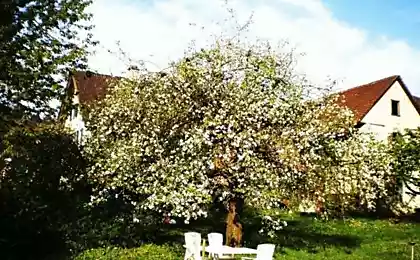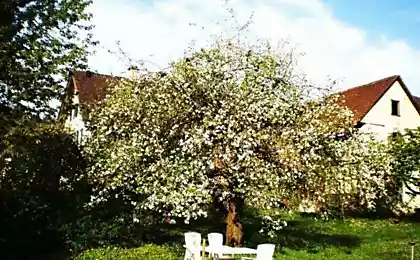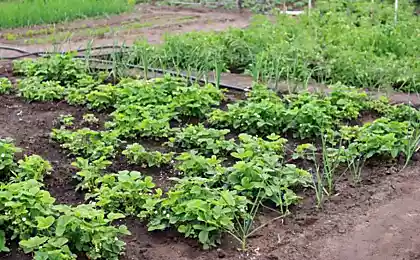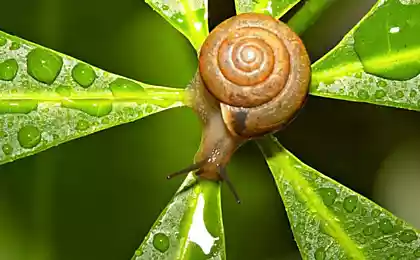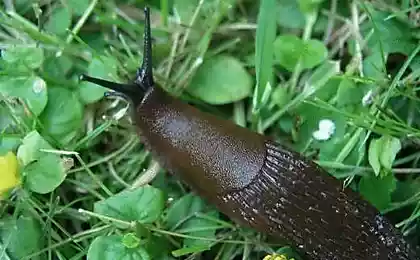549
Hunting belt — an effective method of combating pests
Hunting belt are good helpers in the fight against insect pests. Wear them in early spring, when overwintering in the ground pests climb the tree trunks to the kidneys, the flowers have to postpone their offspring, and autumn, during the ripening of fruits and berries, when from a worm-eaten fallen apples and berries caterpillars crawl again into the trees. For the season, located on the trunk of the lovchy belt, made by hand, capable of destroying the insect in the amount of up to 40% of all pests. For example, butterfly Codling moth second generation is starting her years in August. At this time to deal with it practically impossible. Especially in the ripening period. However, if you use a belt, it is possible to catch huge numbers of caterpillars. Thereby to reduce the number of butterflies of a second generation.
Hunting belt is a wide strip (15-20 cm) of straw plaits, thick paper, matting, shavings, blend rings on the trunks and thick branches of trees to kill pests.

Huntsman's belt — a funnel.
The most common types of dry hunting zones from pests are "funnel". Such name appeared not only due to its specific appearance, but also to the effect of "attracting" insects trapped inside. Such belts are made in the following way: cardboard or paper sheet of paper thickness in average of 20 inches wrapped around the tree trunk at a height of approximately 50 centimeters from the ground. You should get konusopodobnyh winding forms a so-called skirt. That is, the upper part of the sheet must be firmly pressed to the tree trunk, and between the bottom side and the tree bark should be light. Top as tightly as possible to fix the sheet to a tree trunk or a bundle of twine, and, if still remain passages, gloss over clay. Paper before it can be impregnated with insecticides, or just regularly inspect the belt and pick out the caterpillars.
One of the variants of the Falconer belt-funnel — rubber gate c curved edges, filled with a decoction of the leaves of this tree oil. For the manufacture of such belts take a rubber sheet with a thickness of about 3-4 mm and wrap around the tree, gluing rubber glue. If insects get into the oil, out they can't. This belt will not need to change with the growth of the trunk, because it is stretched and will not easily spoil.
Double-sided funnel.
In this case, take the paper strip with a width of about 30 cm and wrapped around the tree, tying the top and bottom. Fasten the belt in the middle as tightly as possible, and the top and bottom left in the form of skirts. This method is quite often used. In this case, paper or burlap is also impregnated with insecticides. Here you can also include the way the trees wrapped in cotton stockings in several places, impregnated with the same insecticides. And another similar way is to wrap glass wool tree, it will create an insurmountable barrier to caterpillars and similar pests.
Adhesive hounds zone.

In this case, a strip of some material wrapped around the tree and liberally smear it with glue which is a long time to dry (e.g., mice and rats). This method has its shortcomings — to the belt stick like pests and beneficial insects — bees, wasps, bumblebees and ladybugs.
Recipes for glue hunting zones.
Pine resin for the turpentine — 10 parts resin and 1.2 parts vaseline — 1.5 parts. All components connect together and cook until the formation of a sticky mass.
Another recipe: tar — 2 parts burdock — 1 part. In boiling tar gently introduce oil and cook on low heat for about 5 hours.
Source: www.sadovoda.ru
Hunting belt is a wide strip (15-20 cm) of straw plaits, thick paper, matting, shavings, blend rings on the trunks and thick branches of trees to kill pests.

Huntsman's belt — a funnel.
The most common types of dry hunting zones from pests are "funnel". Such name appeared not only due to its specific appearance, but also to the effect of "attracting" insects trapped inside. Such belts are made in the following way: cardboard or paper sheet of paper thickness in average of 20 inches wrapped around the tree trunk at a height of approximately 50 centimeters from the ground. You should get konusopodobnyh winding forms a so-called skirt. That is, the upper part of the sheet must be firmly pressed to the tree trunk, and between the bottom side and the tree bark should be light. Top as tightly as possible to fix the sheet to a tree trunk or a bundle of twine, and, if still remain passages, gloss over clay. Paper before it can be impregnated with insecticides, or just regularly inspect the belt and pick out the caterpillars.
One of the variants of the Falconer belt-funnel — rubber gate c curved edges, filled with a decoction of the leaves of this tree oil. For the manufacture of such belts take a rubber sheet with a thickness of about 3-4 mm and wrap around the tree, gluing rubber glue. If insects get into the oil, out they can't. This belt will not need to change with the growth of the trunk, because it is stretched and will not easily spoil.
Double-sided funnel.
In this case, take the paper strip with a width of about 30 cm and wrapped around the tree, tying the top and bottom. Fasten the belt in the middle as tightly as possible, and the top and bottom left in the form of skirts. This method is quite often used. In this case, paper or burlap is also impregnated with insecticides. Here you can also include the way the trees wrapped in cotton stockings in several places, impregnated with the same insecticides. And another similar way is to wrap glass wool tree, it will create an insurmountable barrier to caterpillars and similar pests.
Adhesive hounds zone.

In this case, a strip of some material wrapped around the tree and liberally smear it with glue which is a long time to dry (e.g., mice and rats). This method has its shortcomings — to the belt stick like pests and beneficial insects — bees, wasps, bumblebees and ladybugs.
Recipes for glue hunting zones.
Pine resin for the turpentine — 10 parts resin and 1.2 parts vaseline — 1.5 parts. All components connect together and cook until the formation of a sticky mass.
Another recipe: tar — 2 parts burdock — 1 part. In boiling tar gently introduce oil and cook on low heat for about 5 hours.
Source: www.sadovoda.ru









